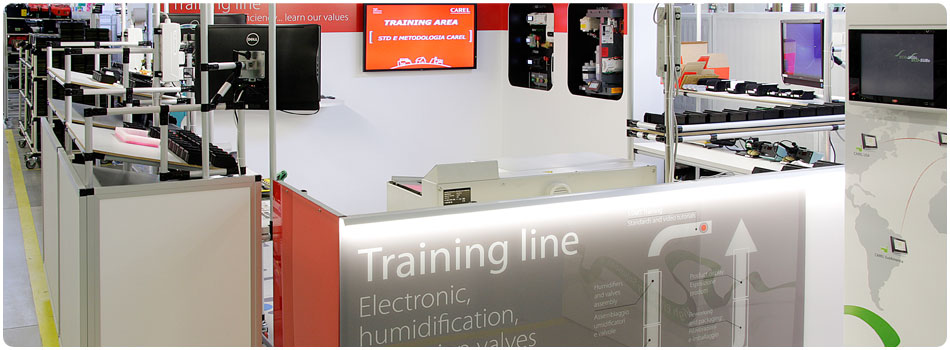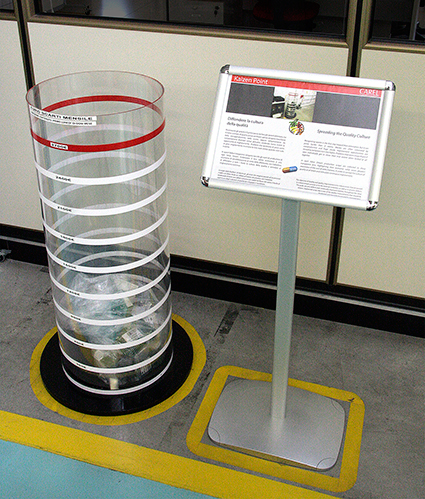LEAN, a philosophy driving growth

CAREL has adopted lean philosophy, a concept based on continous improvement with the aim of increasing value for customers and reducing waste. CAREL interprets lean not as a project, with a start and end date, but rather as a philosophy that pervades all its activities. It is not therefore solely focused on tools or individual projects. It is a method that involves people, making them the centre of improvement activities. It is a modus operandi devised to fulfil the need to constantly improve even simple actions, and perfect our work in small steps, day-after-day (Kaizen).
Our approach to lean commenced in 2007, and since then the model has been extended to cover all of our production sites. It is an evolving process that is also spreading to other contexts within the company, and indeed is an approach that can be adapted to all company areas.
For Carel, one critical success factor is product innovation: 20% of Carel's employees are knowledge workers involved in the new product development process (R&D). For this reason, lean transformation began at an office level, for the purpose of improving performance in the development of new products.
Rather than forcing upon employees a model of efficiency devised by experts, CAREL has chosen to accompany its people throughout their development. Starting from the bottom and stimulating employees to grow within the process. The measurable result is proactivity. The tendency for change that is triggered between people. "The real result", stated Alfredo Ingenito, Operations Quality & Process Improvement, "is not the proposal of new ideas. It is the tendency for change. The ability to think critically and continuously envision new solutions. If people have the right tools, skills and enough time, they can independently generate successful ideas".
Bottom-up involvement
This is why, for example, production lines are brought to a stop for two hours a week at all of the group's production sites, to allow all operators to carry our continuous improvement activities; by involving the people who work on the production lines every day, we can maximise the efficiency and effectiveness of improvement activities, as well as increasing a sense of participation and belonging.
The same concept is applied in the new product development area (R&D). Each employee has four hours available every week to improve the way they work, delivering, testing and sharing standards, knowledge and best practices.
It is a much slower process than simply imposing a model from above. Yet it has the major advantage of making people autonomous and aware, and above all guaranteeing the sustainability of the adopted activities over time. Moreover, the resulting improvement is proprietary and not changeable by outside parties. It belongs to CAREL and the people who conceived it.

The results of Lean
This philosophy has brought surprising results. It is estimated that for every hour spent on continous improvement in production, three are saved in cycle times. In addition, production rejects have fallen by 59%, turnover per square metre has increased by 47%, service levels have risen by 9% and the number of defects has halved.
R&D project development time has been reduced by 20%, output quality level has increased, as has the level of involvement and motivation of personnel. These results have been achieved by applying a new matrix organisation (two boss organisation) and compact, multifunction teams that work on one project at a time (one piece flow concept).
These are the reasons why CAREL is considered a reference point by academics regarding lean philosophy. Universities, business schools and masters courses all use CAREL to train their students (resulting in scientific publications, references in books and several theses). We also host visits and receive many requests for further information for individual research dissertations, or to share experiences with other companies.
What is the lean model?
The term lean was first applied in the 1980s by US academics to the production methods they had observed at Toyota plants in Japan.
The objectives of lean transformation are:
• to have more rational and orderly processes that support growth, by working better and not more
• to gain a competitive advantage by achieving the highest performance in terms of operating results.
These results are obtained by continously applying, to all contexts, the five fundamental principles of a lean organisation, which are:
1. Identify customers and specify value;
2. Eliminate waste (muda);
3. Create flow, adopting short cycles (one thing at a time, start and end);
4. Respond to customer pull;
5. continously improve by pursuing perfection (kaizen).

